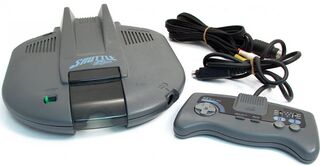Difference between revisions of "PC Engine Shuttle"
From NEC Retro
| (4 intermediate revisions by 2 users not shown) | |||
| Line 4: | Line 4: | ||
| imgwidth= | | imgwidth= | ||
| name= | | name= | ||
| − | | maker=[[NEC]] | + | | maker=[[NEC Home Electronics]] |
| releases={{releasesPCE | | releases={{releasesPCE | ||
| pce_date_jp=1989-11-12 | | pce_date_jp=1989-11-12 | ||
| pce_rrp_jp=18,800 | | pce_rrp_jp=18,800 | ||
| + | | pce_code_jp=PI-TG2 | ||
}} | }} | ||
}} | }} | ||
| Line 13: | Line 14: | ||
==Hardware== | ==Hardware== | ||
| − | The PC Engine Shuttle stands as | + | The PC Engine Shuttle stands as NEC's first attempt to reduce manufacturing costs of the PC Engine, though thanks to the state of the market at the time, the reductions were not passed on to the Japanese consumer, who could purchase a regular PC Engine for roughly the same price. Furthermore the Shuttle has a radically different design which makes it incompatible with most PC Engine add-ons (without significant modifications) - it lacks the rear expansion port for the [[CD-ROM²]], and is significantly bigger in size than a standard PC Engine console. The Shuttle came packaged with the [[Turbo Pad II]] controller, which is shaped differently from a standard [[Turbo Pad]]. Like the later-released [[PC Engine CoreGrafx]], it replaced the original PC Engine's RF output with a composite A/V output port. |
| − | |||
| − | The Shuttle | ||
==Physical scans== | ==Physical scans== | ||
| Line 26: | Line 25: | ||
}} | }} | ||
| − | + | ==References== | |
| + | <references/> | ||
| + | |||
{{PCEngine}} | {{PCEngine}} | ||
Latest revision as of 00:45, 8 December 2022

| ||||||||||
| PC Engine Shuttle | ||||||||||
|---|---|---|---|---|---|---|---|---|---|---|
| Manufacturer: NEC Home Electronics | ||||||||||
|
This teeny-tiny article needs some work. You can help us by expanding it.
The PC Engine Shuttle (PCエンジンシャトル) is a cost-reduced PC Engine console released in Japan in late 1989.
Hardware
The PC Engine Shuttle stands as NEC's first attempt to reduce manufacturing costs of the PC Engine, though thanks to the state of the market at the time, the reductions were not passed on to the Japanese consumer, who could purchase a regular PC Engine for roughly the same price. Furthermore the Shuttle has a radically different design which makes it incompatible with most PC Engine add-ons (without significant modifications) - it lacks the rear expansion port for the CD-ROM², and is significantly bigger in size than a standard PC Engine console. The Shuttle came packaged with the Turbo Pad II controller, which is shaped differently from a standard Turbo Pad. Like the later-released PC Engine CoreGrafx, it replaced the original PC Engine's RF output with a composite A/V output port.
Physical scans
References
| PC Engine |
|---|
| PC Engine (1987) | CoreGrafx (1989) | CoreGrafx II (1991) X1 Twin (1987) | PC-KD863G (1988) | Shuttle (1989) | GT (1990) | LT (1991) |
| Add-Ons |
| AV Booster (1988) | Interface Unit (1988) | Ten no Koe 2 (1989) | Backup Booster (1989) | Backup Booster II (1989) | Ten no Koe Bank (1991) | Memory Base 128 (1993) |
